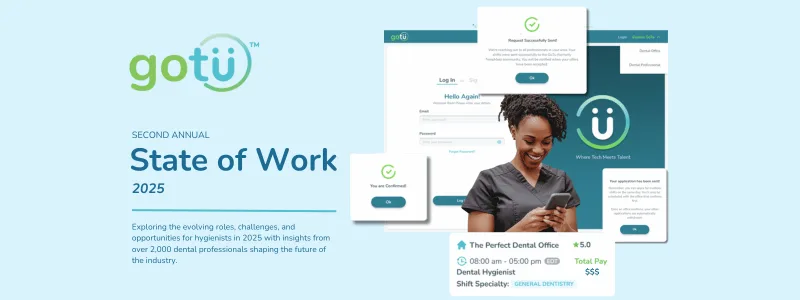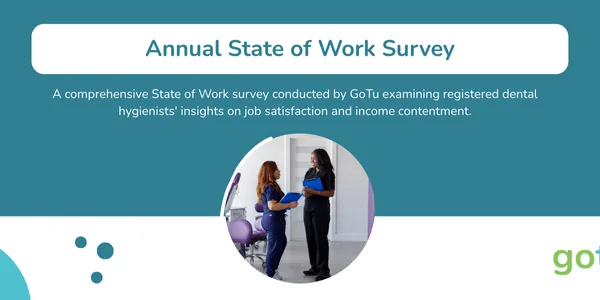Abstract
The dental hygiene profession is undergoing significant transformation as workforce priorities shift toward financial stability, career flexibility, and burnout prevention. GoTu’s 2025 State of Work Report analyzes employment trends and workplace satisfaction among registered dental hygienists, offering insights into the factors influencing retention and mobility. This cross-sectional study surveyed 2,087 registered dental hygienists nationwide to assess employment status, compensation satisfaction, and workplace challenges.
Findings reveal that 79% of registered dental hygienists intend to remain in the field for at least another decade, while 21% anticipate leaving due to physical demands, burnout, and limited growth opportunities. Career mobility remains high, with 67% of hygienists having changed practices primarily for better compensation and flexibility. Financial concerns persist, as 44% of respondents reported no raise in two years, and 66% do not receive any form of monetary bonus. Additionally, 56% of registered dental hygienists have financial dependents, underscoring the need for stable employment and competitive wages.
Temporary and non-traditional work is becoming more prevalent, with the majority of registered dental hygienists having worked in temporary roles at some point in their careers. While this practice offers flexibility and financial benefits, challenges such as inconsistent scheduling, adapting to different office environments persist.
To sustain a thriving workforce, the industry must adapt by enhancing wages to remain competitive, expanding benefits, and fostering supportive work environments. By prioritizing flexibility, competitive compensation, and job satisfaction, dental practices and industry leaders can better attract, retain, support hygienists and ensure long-term workforce stability.
Literature Review
The evolving dental hygiene workforce faces challenges related to job satisfaction, burnout, and employment stability. American Dental Association’s Health Policy Institute reported in its 2023 Economic Outlook and Emerging Issues in Dentistry Specialist Report that, for majority of general practices, recruiting staff to fill dental hygienist roles has been extremely challenging, further emphasizing the need for retention of registered dental hygienists.¹
A 2021 study published in the Journal of Dental Hygiene found that job satisfaction and burnout were significantly linked to registered dental hygienists’ intention to leave their jobs.2 Higher job satisfaction predicted a lower likelihood of leaving, while feelings of disengagement and exhaustion increased the likelihood of considering another job.²
Building on these findings, the 2025 State of Work Report examines employment trends, compensation satisfaction, and workplace challenges to provide insights for industry stakeholders on workforce sustainability.
Methods
A cross-sectional survey research design, a method effective for assessing the prevalence of characteristics within a specific population at a single point in time, was employed using a convenience sample of registered dental hygienists.³ The electronic survey, administered via Typeform©, incorporated a mix of question formats, including multiple-choice and open-ended questions, to capture both quantitative and qualitative data, consistent with best practices in survey methodology.⁴ To maximize reach, we distributed the survey through multiple channels, including email, the GoTu platform, social media, and the GoTu website. Descriptive statistics were employed to summarize the survey results, providing a clear overview of trends and patterns within the data.
Discussion
The findings from GoTu’s 2025 State of Work Report illustrate a workforce in transition, driven by evolving employment expectations, financial responsibilities, and industry-wide structural changes. The dental hygiene profession is now characterized by an increasing demand for flexibility, competitive compensation, and a supportive work environment. The growing interest in flexible work arrangements reflects a broader workforce trend favoring autonomy and work-life balance over rigid employment structures. Addressing these evolving needs will require a comprehensive approach that not only enhances employment conditions but also fosters long-term career sustainability within the field.
Table I. Respondents’ career longevity and job satisfaction (n=2,087)
Do you anticipate working in the hygiene industry for more than 10 years?
| Response | n | % |
|---|---|---|
| Yes | 1649 | 79 |
| No | 438 | 21 |
Why not more than 10 years?*
| Reason | n | % |
|---|---|---|
| Physical Demand | 241 | 55 |
| Lack of Growth | 142 | 32.4 |
| Income Opportunity | 91 | 20.8 |
| Burnout | 186 | 42.5 |
| Workplace Culture | 87 | 19.9 |
| Other | 64 | 22.6 |
What factors contribute to your overall satisfaction?**
| Factor | n | % |
|---|---|---|
| Competitive Salary | 1496 | 71.7 |
| Job Security | 1166 | 55.9 |
| Career Development | 638 | 30.6 |
| Positive Work Environment | 1232 | 59 |
| Variety of Tasks | 517 | 24.8 |
| Flexibility in Work Schedule | 1469 | 70.4 |
Have you experienced burnout in your professional career?
| Response | n | % |
|---|---|---|
| Yes | 1321 | 63.3 |
| No | 766 | 36.7 |
Have you encountered challenges in communication or collaboration?
| Response | n | % |
|---|---|---|
| Yes | 1379 | 66.1 |
| No | 708 | 33.9 |
*Respondents were only asked the question “Can you please share why?” if they responded “No” to “Do you anticipate working in the hygiene industry for more than 10 years?”
**Respondents were able to select multiple options for the question “What factors contribute to your overall satisfaction as a registered dental hygienist?”
Career Longevity and Retention in the Dental Workforce
The dental hygiene profession exhibits a strong commitment to long-term career stability, with the majority of registered dental hygienists anticipating remaining in the field for over a decade based on responses.
However, a significant portion of registered dental hygienists are anticipating leaving the profession within the next ten years, citing physical demands (55%) and burnout (43%) as primary concerns. It was noted in a 2020 study that physical stress, including joint pain and back pain, was significantly associated with an increased likelihood of leaving clinical dental hygiene within the next year.5 These statistics highlight the need for improved working conditions, including ergonomic advancements, reduced workload strain, and greater mental health support.
Workplace Environment and Job Satisfaction
While compensation is a key determinant of job satisfaction, workplace culture and professional support play equally significant roles. Burnout remains a significant challenge within the profession, with 63% of respondents reporting experiencing burnout at some point in their careers. Workplace stress, physical demands, and job dissatisfaction contribute to these high rates, emphasizing the need for better work-life balance.
Table II. Respondents’ compensation and benefits (n=2,087)
What is your hourly rate?
| Hourly Rate | n | % |
|---|---|---|
| $20-$30 Per Hour | 52 | 2.5 |
| $31-$40 Per Hour | 190 | 9.1 |
| $41-$50 Per Hour | 714 | 34.2 |
| $51-$60 Per Hour | 737 | 35.3 |
| $60-$70 Per Hour | 335 | 16.1 |
| $71-$80 Per Hour | 48 | 2.3 |
| $81+ Per Hour | 11 | 0.53 |
Have you received a pay raise in the last 24 months?
| Response | n | % |
|---|---|---|
| In The Last 3 Months | 269 | 12.9 |
| In The Last 6 Months | 273 | 13.1 |
| In The Last 12 Months | 408 | 19.5 |
| In The Last 18 Months | 102 | 4.9 |
| In The Last 24 Months | 127 | 6.1 |
| I Have Not Received A Pay Raise | 908 | 43.5 |
How satisfied are you with your current income as a registered dental hygienist?
| Satisfaction (0–5) | n | % |
|---|---|---|
| 0 | 98 | 4.7 |
| 1 | 113 | 5.4 |
| 2 | 314 | 15.1 |
| 3 | 508 | 24.3 |
| 4 | 645 | 31 |
| 5 | 409 | 19.6 |
Do you have any financial dependents?
| Response | n | % |
|---|---|---|
| Yes | 1,174 | 56.3 |
| No | 913 | 43.7 |
*Respondents were able to select multiple options for the question “What benefits are you receiving in your current role?”
Financial stability remains a central concern for registered dental hygienists, with 56% reporting financial dependents. This figure highlights the critical role of income security in career decision-making, reinforcing the importance of reliable wages, predictable employment, and access to essential benefits.
Despite relatively strong earning potential, with 70% of hygienists earning between $41-$60 per hour, income satisfaction varies significantly. While 31% rate their earnings positively, 25% express dissatisfaction, with concerns about stagnant wages and the absence of regular pay increases. Alarmingly, 44% of surveyed hygienists reported not receiving a pay raise in the past two years. The lack of consistent wage growth, combined with rising living costs, could contribute to increased attrition in the profession.
Table III. Respondents’ workplace experience and career changes (n=2,087)
Have you ever left one practice to work for a different practice?
| Response | n | % |
|---|---|---|
| Yes | 1390 | 66.6 |
| No | 697 | 33.4 |
Are you considering a job change?*
| Response | n | % |
|---|---|---|
| Yes | 513 | 49.5 |
| No | 523 | 50.5 |
Why are you considering a job change?**
| Reason | n | % |
|---|---|---|
| I want to increase my income. | 376 | 73.3 |
| I would like better benefits from my employer. | 205 | 40 |
| I want more flexibility in my schedule. | 24 | 30 |
| I am unhappy with my current office dynamics. | 15 | 29 |
Have you ever worked as a temporary registered dental hygienist?
| Response | n | % |
|---|---|---|
| Yes | 1914 | 91.7 |
| No | 173 | 8.3 |
*Respondents were only asked the question “Are you considering a job change?” if they responded “3” or lower to “How satisfied are you with your current income as a registered dental hygienist?”
**Respondents were only asked the question “Why are you considering a job change?” if they responded “Yes” to “Are you considering a job change?”
***Respondents were able to select multiple options for the question “What factors would influence your decision to take on temporary registered dental hygiene assignments?”
Workforce Dynamics and Employment Trends
67% of surveyed hygienists have transitioned between dental practices, often in pursuit of better pay, improved benefits, and more flexibility. Practices that fail to meet evolving expectations risk higher turnover rates, which can disrupt patient care and operational stability.
Furthermore, the role of non-traditional employment in dental hygiene is expanding. The majority of hygienists (92%) have worked as temporary professionals at some point in their careers, emphasizing the appeal of flexibility and financial autonomy. However, despite these benefits, challenges such as inconsistent scheduling, lack of benefits, and adapting to different office environments persist.
Recommendations
The dental hygiene profession stands at a crossroads, shaped by shifting workforce priorities, evolving financial realities, and growing demands for flexibility and support. GoTu’s 2025 State of Work Report reveals a workforce with strong long-term commitment but significant underlying challenges that threaten retention and overall job satisfaction.
Compensation remains a key driver of satisfaction and career stability, yet nearly half (44%) of surveyed hygienists reported not receiving a pay increase in the last two years, despite increasing workloads and rising living costs. This stagnation, combined with inconsistent access to benefits like health insurance (32%) and CE reimbursement (29%), underscores the urgent need for more competitive compensation models and enhanced benefit structures.
Burnout is a persistent challenge, with 63% of hygienists reporting experiencing it at some point in their careers. Emotional demands, physical strain, and lack of support may contribute to these high rates, making it essential to address workplace culture and implement strategies that promote better work-life balance.
To ensure long-term sustainability, the industry should enhance compensation structures, expand career development opportunities, improve workplace conditions, and support flexible work arrangements. Strategic efforts such as structured pay raises, leadership training, ergonomic improvements, and phased retirement programs will create a more stable and rewarding career path, improving both professional satisfaction and patient care outcomes. The future of the profession hinges on the ability of employers and industry stakeholders to adapt to these workforce shifts.
References
-
American Dental Association Health Policy Institute. Economic outlook and emerging trends in dentistry: results from a survey of specialists [Internet]. Chicago (IL): American Dental Association; 2023 Nov [cited 2025 Mar 7]. Available from:
https://www.ada.org/-/media/project/ada-organization/ada/ada-org/files/resources/research/hpi/nov2023_hpi_economic_outlook_denitstry_report_specialist.pdf
. - Patel BM, Boyd LD, Vineyard J, LaSpina L. Job Satisfaction, Burnout, and Intention to Leave among Dental Hygienists in Clinical Practice. J Dent Hyg. 2021 Apr;95(2):28-35. PMID: 33875527.
- Setia MS. Methodology Series Module 3: Cross-sectional Studies. Indian J Dermatol. 2016 May-Jun;61(3):261-4. doi: 10.4103/0019-5154.182410. PMID: 27293245; PMCID: PMC4885177.
- Patten ML, Newhart M. Understanding Research Methods: An Overview of the Essentials. 10th ed. New York: Routledge; 2017.
-
Malcolm, N., Boyd, L., Giblin-Scanlon, L., & Vineyard, J. (2020). Occupational stressors of dental hygienists in the United States. Work, 65(3), 517–524.
https://doi.org/10.3233/WOR-203106







